The Hanseatic League - who were they really?
Whilst researching another subject I kept coming across The Hanseatic League: a 400 year long economic alliance of 194 cities in 16 countries whose merchants had trade routes throughout the North Sea and the Baltic Sea, headquartered in Lübeck, Germany. They developed an economic reach which, during the 16th century, ranged from Portugal to Russia and from the Scandinavian countries to Italy, an area that now includes 20 European states.
According to the Hanseatic League themselves, or rather their modern incarnation (reborn in 1980,) it developed from the “Artlenburger Privilege” of 1161 whereby the privileges that were already enjoyed within the Empire of Henry the Lion, duke of Saxony and Bavaria, by the German long-distance merchants (elsewhere on the site described as Dutch) were extended to their competitors from Gotland. For example duty-free treatment, protection and freedom based on mutual trust. However, they put this forward as a “could be” rather than as a fact. The Hanseatic League itself didn’t form until the mid 13th century.
“In its heyday, the Hanseatic League was so powerful that it imposed economic blockades against kingdoms and principalities to enforce their economic interests and in exceptional cases even waged wars.
“From the 13th to the middle of the fifteenth century, the Hanseatic League largely dominated the exchange of goods between the north-east and the north-west of Europe by covering the raw material and food supplies of the West from the East, which had been opened by the German colonization, and the east with the Western- Products. These included, for example, furs, wax, grain, fish, flax, hemp, wood and timber products such as pitch, tar and potato [potatoes!? But, but, but they come from South America and didn’t arrive in Europe until the 16th century… or so we’re supposed to believe.] In return, the Hanseatic merchants brought into these countries the industrial finished products of the West and South like cloths, metal goods, especially weapons, and spices.
“Since the second half of the 14th century, however, the hanseatic cities were trying to create a firmer alliance organization for mutual support against aristocratic rule claims. With this firmer union, they also wanted to face problems caused by the growing competition of English, Italian and South German merchants and Dutch freightmen and by the state strengthening in the target countries of the trade. The pressure from the outside was thus the reason why the cities of the Hanseatic League („stede van der dudeschen hense) joined together as a group on the first hanseatic day in Lübeck in 1358.

The Lübeck Coat-of-Arms
“However, the development [of the competition] could not be stopped and the influence of the Hanseatic League was reduced, although trade in the 16th and early 17th century still showed enormous growth.
“The emerging national and territorial economies left no room for a supraregional trade union such as the Hanseatic merchants and Hanseatic towns. The Reformation also split the cohesion.
“In the middle of the 16th century Heinrich Sudermann was hired as the first managing director (syndic) to free the Hanseatic League from their difficult situation. In spite of some successes, as well as his successor, he lacked the self-assetion against the personal interests of the merchants and cities.
“The Thirty Years' War (1618-1648) [F: the German Revolution?] finally destroys the trading area of Hanseatic merchants. There was no longer any thought of an orderly trade of goods.
In 1669 the last hanseatic day of the Hanseatic League took place in Lübeck." Source
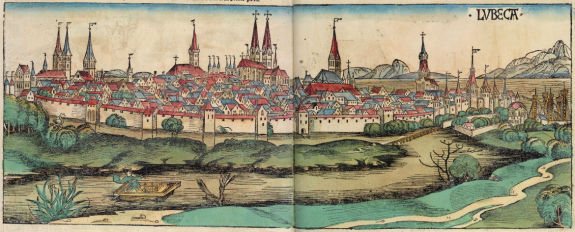
Lübeck 1498 Source
Apparently, since the early 13th century, successive English kings had allowed them to trade freely in England, immune from rent and taxation in exchange for surrendering their vessels in wartime. 'The Steelyard' in The City of London was...
“the residence of the Hanse Town, German and Flemish merchants who obtained a settlement in London as early as 1250. Henry III, in 1259 at the request of his brother Richard, Earl of Cornwall, granted them very valuable privileges, renewed and confirmed by Edward I. The City also conceded them many privileges, on condition of their maintaining Bishopsgate in repair (they rebuilt it once), and sustaining a third of the charges in money and men to defend it when need was. In spite of English jealousy, the Steel Yard merchants flourished till the reign of Edward VI, when the Merchant Adventurers complained of them and they were held, like all other strangers to have forfeited their liberties. In vain Hamburg and Lubeck sent ambassadors to intercede for their countrymen. Their monopoly was gone, but the Steel Yard men still throve, and continued to export English cloth. Elizabeth, however, was rougher with them, and finally expelled them from the country in 1597-8.” Walter Thornbury, Old and New London: Volume 1, 1878. Source
The official narrative is highly suspect because it also states that they were still there at the time of the Great Fire of London in 1666. By then they had supposedly been forced to wall off the Steelyard due to hostility from the other merchants. Lo and behold, in the Great Fire of London ‘story’ their complex was razed to the ground… or was it? More on this later.
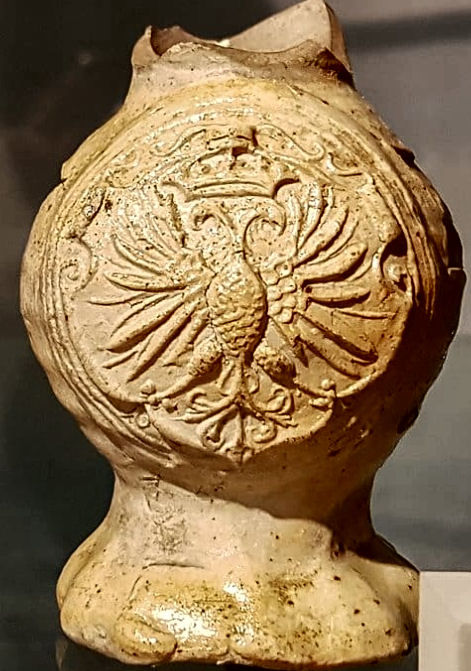
Hansa coat-of-arms on a mug from, they’re guessing, 1550 -1585 Source

Coat-of-arms from the Steelyard, carved in 1670 (4 years after the fire!) Source
Please note the double-headed eagle and in the 1670 version the crown has slipped down around the eagles’ necks.
The main German city associated with the Hanseatic League is Lübeck. I read a post on stolenhistory.org which claimed that the Romanovs had something to do with Lübeck, but I can't remember where I found it. Anyway, the heraldry of Lübeck is very interesting:

Lübeck Coat-of-Arms Source
Also the city of Lübeck is (or was) a ‘star fort'…
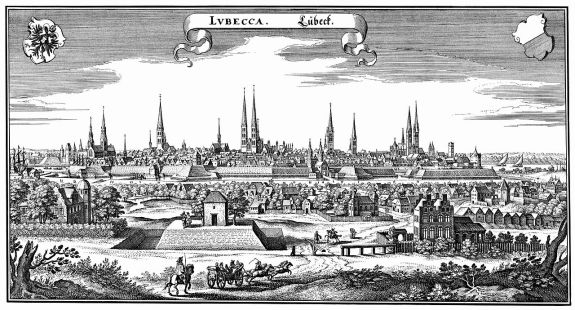
Lübeck 1641 Source
The so-called Hanseatic architecture is also very interesting…

Lübeck Holsten Gate Source
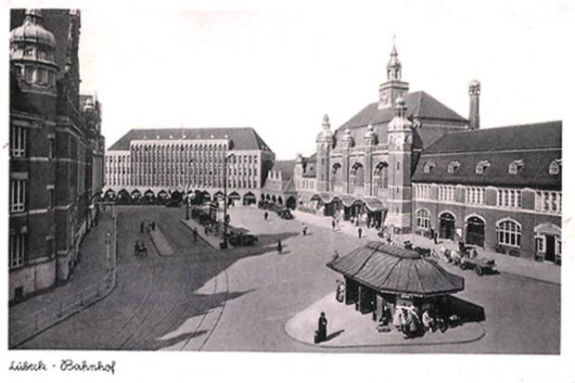
Lübeck Railway Station and Tram Terminal (pre both wars)
Source: (ibid)
Their ships are often shown displaying what resembles the Templar Cross, but which has since been associated with the ‘Nazis' as the Iron Cross…

14th century sailing ship of the Hanseatic League
According to Wikipedya ;
“Rise of rival powers.
The economic crises of the late 15th century did not spare the Hansa. Nevertheless, its eventual rivals emerged in the form of the territorial states, whether new or revived, and not just in the west: Ivan III, Grand Prince of Moscow, ended the entrepreneurial independence of Hansa's Novgorod Kontor in 1478—it closed completely and finally in 1494. New vehicles of credit were imported from Italy, where double-entry book-keeping was invented in 1492, and outpaced the Hansa economy, in which silver coins changed hands rather than bills of exchange."
So, the Hanseatic League used real money, whereas the new competition used ‘vehicles of credit' and ‘bills of exchange'. Hmmm...
I have been attempting to cobble together a timeline of The Hanseatic League and their activities in the City of London Steelyard Kontor. There are many contradictions within the different sources, as will be seen. This is the best I could manage:
The Hanseatic League was never officially dissolved.
Did it really have a wall around it?
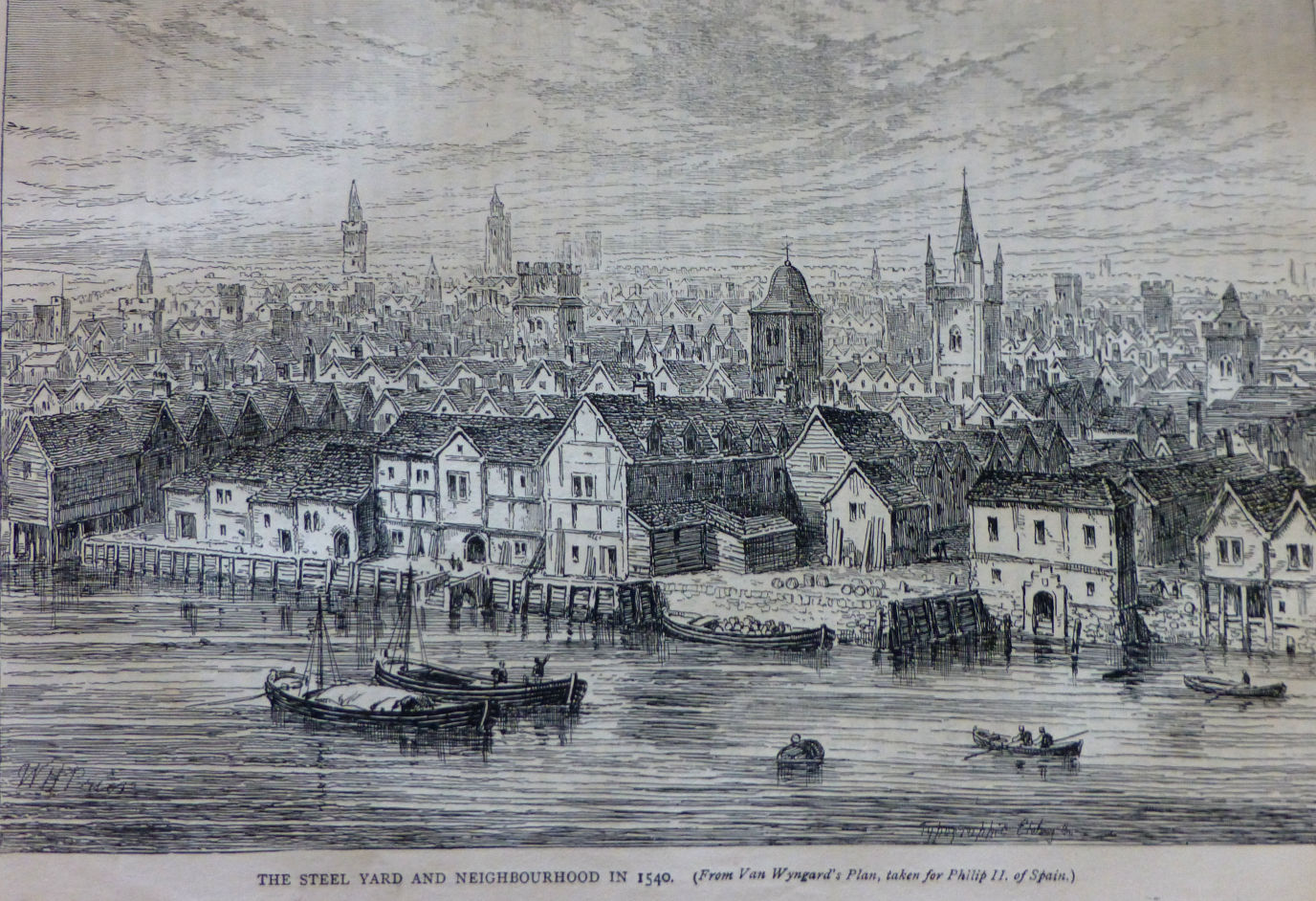
The Steelyard 1540 Source
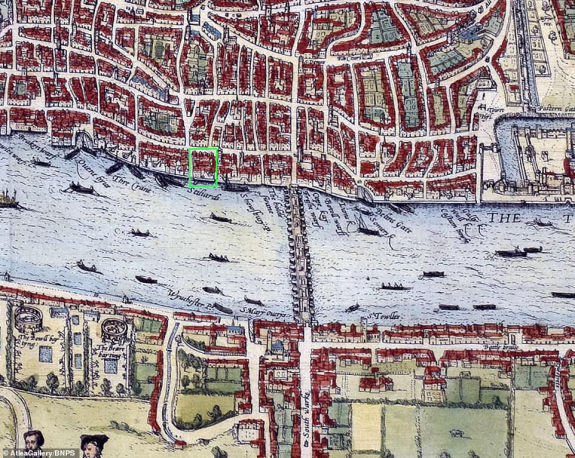
Map of London from 1572, by the engraver Frans Hogenburg.
Commissioned by the Hanseatic League. No wall. Compare it to the
Tower of London on the extreme right. Now that's a wall. Source

Steelyard plan 1667, no wall and was supposed to have been destroyed a year earlier. Source
Finally and this was a bit of a clincher for me, during World War II, Lübeck became the first German city to suffer substantial Royal Air Force bombing. The attack of 28 March 1942 created a firestorm that caused severe damage to the historic centre.
That the Hanseatic League even existed seems like a minor miracle given the political chaos that we are given to believe was occurring in Germany during the period of their existence. Much of what is stated regarding them is clearly misleading and contradictory. Their eventual decline, which again is shrouded in mystery and innuendo, coincides with the decline of the German colonial empire itself and seems to reveal a hidden agenda against all things German. These days it’s being touted as the birth of globalism and the prototype European Union (although I think they really mean ‘Common Market’ as it used to be called when I voted not to join it in 1975.)
A further consideration in the decline of the Hansa is the rise of the so-called ShUM cities of Speyer, Worms and Mainz in the German Rhineland. This was supposedly the first Jewish settlement in Northern Europe, occurring during the 10th to 11th centuries AD. It became a major international trading centre. (More details here.)
Timeline Sources:
Steelyard - Wikipedia
Prof. Rainer Postel, The Hanseatic League and its Decline
The Wards of Old London: Dowgate - Hanseatic Trade and Roman Governance
Fair Trade? A Look at the Hanseatic League - Medievalists.net
Bishopsgate - Wikipedia
Carta Mercatoria - Wikipedia
Merchants of the Steelyard - Wikipedia
Commerce raiding - Wikipedia
Anglo-Hanseatic War - Wikipedia
So, who were they really? Were they actually a remnant of the previous civilisation? Was there a connection between the Hanseatic League and the Knights Templar?
Information contributed by stolenhistory.org member Plissken:
After 1400, political forces turned against the methods of the Italian free enterprise bankers (Phoenicians/Pharisees) and in 1401, King Martin I of Aragon had some of these bankers expelled. In 1403, Henry IV of England prohibited them from taking profits in any way in his kingdom. In 1409, Flanders imprisoned and then expelled Genoese bankers. In 1410, all Italian merchants were expelled from Paris.
Later, when modern banking practices became wide-spread, the Italian Warlord Banking Families became prominent again, especially between 1527 and 1572 when Italy produced these banking family groups: the Grimaldi, Spinola, Pallavicino, Doria, Pinelli and Lomellini.
In Germany, we find many Italian banking families migrating to Hamburg and becoming the hidden money behind the Hanseatic League. An early trading company that used Spanish and Portuguese merchant sailors in the lucrative spice trade. These early unions of rich bankers investing in trade became the basis for what would become corporations like the Dutch and British East India companies. In southern Germany, two great banking families emerged in the 15th Century, the Fuggers and the Welsers. They basically came to control much of the European economy and dominated international high finance in the 16th Century [FN: greedy fuggers.] The Fugger Bank lasted from 1486 to 1647.
Also important to the Northern German city states establishing powerful banks was the influence of Dutch bankers. Berenberg Bank is the oldest bank in Germany and the world’s second oldest bank, established in 1590 by Dutch brothers Hans and Paul Berenberg in Hamburg. The bank is still owned by the Berenberg Warlord Banking Family. Throughout the 17th Century, precious metals from the New World, Japan and other locales were being channeled into the Bank of Amsterdam. The Netherlands attracted coin and bullion to be deposited in their banks until they became a leading force of banking. The concepts of fractional-reserve banking and payment systems were developed and spread to England and elsewhere from Holland.
The dutch banks eventually set up the Dutch East and The Dutch West trading companies because of the success of the Hanseatic league. Later in the article, the writer makes this point:
The actual first Warlord Corporation would be the Dutch East India Company which became the largest slave-trader in the world and started countless conflicts and wars to feed their coffers. At its height, the “Company” was more powerful than the nation that created it and remained so for hundreds of years. It is still active today in many subtle, and sometimes invisible ways. Corporate imperialism, industrial espionage, and the machinations of the military industrial complex all find their roots in the Dutch East India Company that competed with and defeated the Hanseatic League of Northern Germany.
Images contributed by by stolenhistory.org members: (Note the Hebrew characters and Masonic symbolism.)
The existence of these coins and the Plissken information above, must surely provoke the question as to whether there was a significant Jewish influence over the Hanseatic League in the 15th century. Given that the banking families were from Italy, there high probability of a connection and once again we see the Jewish/Catholic/Jesuit alliance at the highest hidden levels.
Felix Noille
.
IF YOU ARE SEEING A LINK TO MOBIRISE, OR SOME NONSENSE ABOUT A FREE AI WEBSITE BUILDER, THEN IT IS A FRAUDULENT INSERTION BY THE PROVIDERS OF THE SUPPOSEDLY 'FREE' WEBSITE SOFTWARE USED TO CREATE THIS SITE. THEY ARE USING MY WEBHOSTING PLATFORM FOR THEIR OWN ADVERTISING PURPOSES WITHOUT MY CONSENT. TO REMOVE THESE LINKS I WOULD HAVE TO PAY A YEARLY FEE TO MOBIRISE ON TOP OF MY NORMAL WEBHOSTING EXPENSES - WHICH IS TANTAMOUNT TO BLACKMAIL. I CALCULATE THAT THEY CURRENTLY OWE ME THREE MILLION DOLLARS IN ADVERTISING REVENUE AND WEBSITE RENTAL.